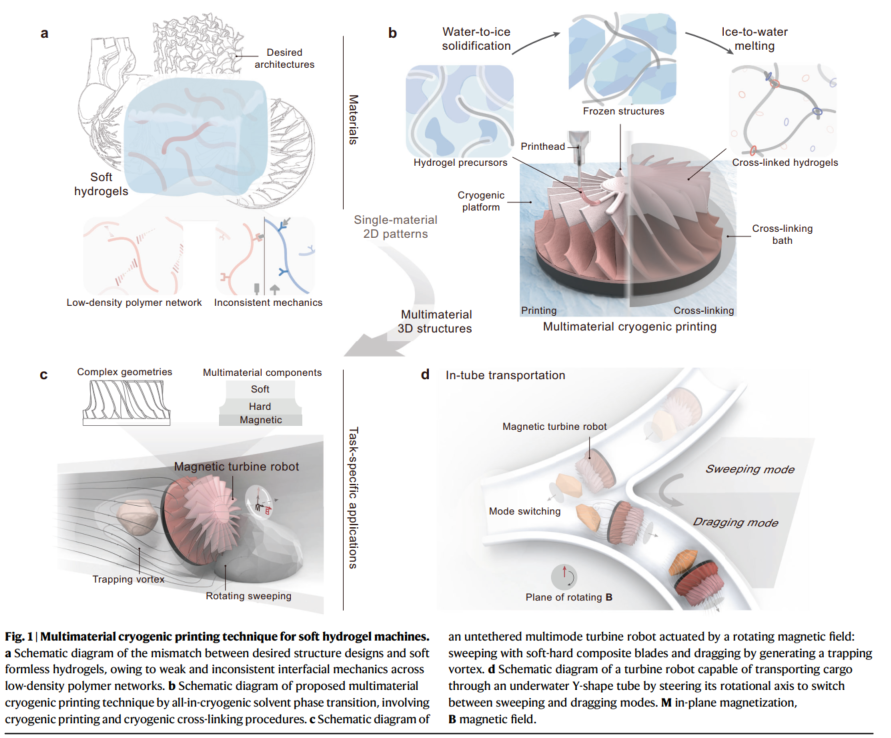1_Multimaterial Cryogenic Printing of Three-Dimensional Soft Hydrogel Machines
🚀 Multimaterial Cryogenic Printing of Three-Dimensional Soft Hydrogel Machines
🗓 Published on: January 2025
📚 Journal/Conference: Nature Communications
🔍 Abstract
This study introduces a novel Multimaterial Cryogenic Printing (MCP) technique to fabricate soft hydrogel machines with intricate architectures and robust multimaterial interfaces. MCP enables precise control over material properties and interface integrity, paving the way for next-generation applications in soft robotics and wearable devices.

Figure 1: Schematic diagram of the MCP technique used in this study.
💡 Key Insights
🌟 Multimaterial Cryogenic Printing
Phase Transition Mechanism:
- Step 1: Instant freezing of hydrogel precursors through water-to-ice phase transition (-30°C to -10°C), locking molecular configurations.
- Step 2: Controlled ice-to-water melting initiates chemical cross-linking at the ice-water interface.
Kinetic Validation and Modeling:
- Developed a theoretical model to describe the relationship between printed linewidth (d) and extrusion flow (Q) for optimized control.
🎨 Demonstration and Applications
1. Printing Performance:
- High precision achieved for complex multimaterial designs.
- Stability maintained across diverse hydrogel compositions.
2. Multimaterial 3D Hydrogel Architectures:
- Robust bonding between materials demonstrated.
- Achieved intricate shapes for advanced soft robotic components.
3. All-Printed, All-Hydrogel Soft Machines:
- Fully functional machines with integrated sensory and actuation capabilities.
- Applications include biomimetic devices and wearable systems.
⚙️ Methods
Experimental Setup
- Utilized a customized cryogenic printer with temperature-controlled stages.
- Hydrogel precursors prepared using biocompatible polymers and additives.
Key Parameters
- Temperature range: -30°C to -10°C.
- Material extrusion speed and flow rates optimized for multimaterial integration.
📊 Results
📏 Printability Limitations:
- Graphene content exceeding 12% rendered inks too viscous for extrusion.
⚡ Electrical Performance:
- Graphene-enhanced hydrogels with 60% content exhibited exceptional conductivity.
📐 Structural Precision:
- Achieved linewidth variations within ±10 µm, showcasing remarkable accuracy.
🗣 Discussion
Strengths:
- Innovative phase-transition-driven fabrication enables multimaterial integration.
- Potential to revolutionize soft robotics and tissue engineering.
Challenges:
- Viscosity constraints limit material diversity.
- Long-term stability of printed structures in dynamic environments needs further exploration.
🌟 Personal Insights
Takeaways:
- MCP is a game-changer for creating multifunctional soft machines.
- Integration of conductive materials expands the utility of hydrogels in wearable electronics.
Future Directions:
- Explore scalability of MCP for industrial applications.
- Investigate potential for bioprinting applications in regenerative medicine.
📖 References
Li, J., Cao, J., Bian, R., Wan, R., Zhu, X., Lu, B., & Gu, G. (2025). Multimaterial cryogenic printing of three-dimensional soft hydrogel machines. Nature Communications, 16(1), 185, DOI: 10.1038/s41467-024-55323-6
1_Multimaterial Cryogenic Printing of Three-Dimensional Soft Hydrogel Machines



